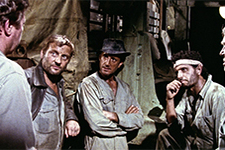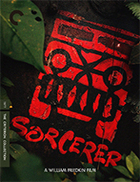Sorcerer (4K UHD)
|  In Peter Biskind’s Easy Riders, Raging Bulls: How the Sex-Drugs-and-Rock’n’Roll Generation Saved Hollywood, legendary editor Bud Smith recounts in a succinct anecdote how and why William Friedkin’s Sorcerer failed so miserably and unfairly at the U.S. box office in the summer of 1977: Watching the Sorcerer trailer he had cut opening in front of Star Wars at the Chinese Theater in Los Angeles, Smith said, “When our trailer faded to black, the curtain closed and opened again, and they kept opening and opening, and you started feeling this huge thing coming over your shoulder overwhelming you, and heard this noise, and you went right off into space. It made our film look like this little, amateurish piece of shit. I told Billy, ‘We’re fucking being blown off the screen. You gotta go see this.’” At that moment—unfortunately—anything that wasn’t Star Wars playing at the same time as Star Wars was doomed. And such was the fate of Sorcerer. Of course, Sorcerer, despite its box office failure, was anything but little and amateurish. It was, in fact, the most expensive and ambitious film Friedkin had made at that point in his career, which was then defined by the massive, culture-rattling impact of his horror masterpiece The Exorcist (1973) and his multi-Oscar-winning police thriller The French Connection (1971). No doubt, Friedkin was at the top of his game, feeling virtually untouchable, and like so many other recently crowned geniuses of the New American Cinema, conventional wisdom suggested that he could do no wrong, which is what explains why not one, but two major Hollywood studios (Paramount and Universal) were willing to put up a combined $22 million (the equivalent of about $130 million today) for Friedkin to shoot a dark, violent, existential thriller set in the South American jungle with no major movie stars and the albatross of being based on a novel that had already been brought to the screen 20 years earlier in Palm d’Or-winning fashion by the venerated French director Henri-Georges Clouzot. Clouzot’s The Wages of Fear (Le Salaire de la peur, 1953), was not particularly well known in the U.S. due to its delayed, limited theatrical release in the mid-1950s that suffered censorship for perceived anti-American themes, but it was still the height of chutzpah for an American director to remake a European classic. (To his credit, Friedkin asked Clouzot’s permission to make his own version of The Wages of Fear when he had dinner with him at the Paris premiere of The Exorcist. Clouzot warned him against the endeavor, but gave his blessing.) Unfortunately, Friedkin became victim to his own ambitions, as Sorcerer, despite being a genuinely great film (arguably superior to Clouzot’s), bombed both financially and critically. It failed at the box office because the juggernaut of Star Wars was simply too all-enveloping for Friedkin’s film to gain any traction with viewers; it was too dark, too despairing, too arty for the mainstream commercial audience that had turned out in droves four years earlier for The Exorcist. They wanted myth-making and space battles and uplift, not sweaty, unshaven antiheroes struggling for survival. Sorcerer’s critical failure is somewhat harder to fathom given the film’s renaissance in recent years (Jack Kroll of Newsweek was the only major critic to praise it at the time of its release). Once the pariah film that began Friedkin’s downward spiral, it has since been rechristened as an underseen and underappreciated masterpiece that was simply the wrong film at the wrong time. Time, as it turns out, has been good to Sorcerer, as it can now, stripped free of competition with Star Wars and Friedkin’s earlier successes, be appreciated for what it: a masterful evocation of human desperation and the most intense and compelling depiction of mankind battling the elements to his own destruction not directed by Werner Herzog. Unlike Clouzot’s film, Sorcerer, which was scripted by Walon Green (The Wild Bunch), begins with four seemingly unrelated incidents in four different parts of the world. It is an unconventional strategy, introducing the quartet of major characters (all of whom are, in Friedkin’s typical style, largely unsympathetic) in what feel like stand-alone short films, each one progressively longer than the previous. The first is the shortest, introducing us to a Spanish assassin named Nilo (Francisco Rabal) making a hit in Veracruz, Mexico. We then jump to Jerusalem, where he witness a Palestinian terrorist named Kassem (Amidou) bomb a bank and then escape while all of his comrades are either shot or captured. Then we are off to Paris, where we meet Victor Manzon (Bruno Cremer), a wealthy investment banker whose life comes unraveled when it is discovered that he and his brother-in-law have been embezzling money, which necessitates that he flee the country. And, finally, in Elizabethtown, New Jersey, we meet Jackie Scanlon (Roy Scheider), a driver for an Irish-American gang whose hit on a mob-affiliated church puts him in the crosshairs of a powerful mob boss. Cut the jump to an unnamed South American country, where all four men are hiding behind Spanish aliases in the squalor of Porvenir, a tiny, impoverished mountain village that is dominated by the presence of a massive American oil company. Moreso than even the most acerbic films of the New Hollywood, Sorcerer is blatantly political, using the narrative props of the thriller to dramatize that way in which American corporate interests exploit developing countries. The abject poverty on display, which Friedkin captures with a raw intensity informed by his background in documentary filmmaking, is contrasted sharply with the relentlessness of the oil company’s interests; it all come to a head when one of the oil wells explodes and catches fire (possible due to anti-American terrorism), killing a number of the villagers who work at the site. When their charred bodies are delivered on a flatbed truck in the village, a riot erupts, pitting the essentially powerless against the police state that oppresses them while allowing for the imperialist exploitation of their resources. It doesn’t get any sharper or more gruesome. To put out the well fire, the oil company seeks a quartet of men desperate enough to drive two trucks 218 miles through treacherous terrain to deliver boxes of highly unstable nitroglycerin to extinguish the blaze. The sheer suicidal nature of the job is testament to the company’s view of its workers as fundamentally expendable (the need for four men driving two trucks makes clear that they don’t expect both of them to make it). After a series of driving tests, Scanlon is paired with Nilo and Victor is paired with Kassem, with each duo commandeering a modified two-and-a-half-ton military cargo truck—colossal monstrosities of steel and oil and rust—the beds of which have been filled with sand to help minimize the inevitable shaking of the wooden boxes housing the old nitroglycerin. (As Steven Spielberg understood so well in Duel, the trucks themselves needed to be characters with discernible faces and personalities, and production designer John Box, a veteran of numerous David Lean films and a four-time Oscar winner, truly delivered.) The rest of the film, which is scored in hypnotic fashion by the German electronic band Tangerine Dream, follows the perilous journey, punctuated by three particular moments of abject danger. In the first instance, the drivers must navigate a crumbling wooden road extension that is constantly threatening to fall apart beneath their trucks’ massive tires. The second, and most famous, instance involves a tattered rope-and-wooden suspension bridge strung across a raging river that the trucks must traverse in a blinding rainstorm. The sheer insanity of these massive vehicles moving inch by inch across a cobbled-together series of tresses that don’t look like they could withstand a dozen people epitomizes both the film’s masterful evocation of suspense and its overwhelming sense of dread. Standing as its own masterpiece of editing, camerawork, and (especially) sound design, the bridge sequence alone should have ensured Sorcerer’s place among the ranks of greatest ’70s American cinema. And, if that were all the film had to offer, it would still be a monumental achievement, but Friedkin has even more lying in wait, as the men are later faced with an enormous downed tree that they must detonate using a contrived explosive contraption. Whereas the bridge sequence is all sturm und drang, audio-visual sound and fury, the downed tree sequence is a masterclass in detail, focusing us intently on the process of putting together the device—cobbled together from hacked tree limbs and twine—that will be the difference between success and failure (literally life or death). Although visually rich and emotionally engaging, Sorcerer is a spare film, a kind of skeleton onto which we hang as much meaning as we would like (the title, which was its own bane to the film’s success, is meant to suggest the omnipresence of fate). Each man is given his own introductory prologue, yet we don’t know much about them outside of their existential desperation, which gives the film a dark, raw vibe that eschews any sense of hope or redemption. The only thing these men can do is survive, and we sense from the outset that most of them will fail in this endeavor. Friedkin was purposefully minimalistic in the use of dialogue, relying heavily on imagery to propel the story. There are some moments of character introspection, especially a late scene in which Victor talks with Kassem about the watch his wife gave him on the day he had to flee France. As the only American actor in the film, much weight is put on the shoulders of Roy Scheider (fresh off the mammoth success of Spielberg’s Jaws), and he plays Scanlon exactly as he should: ragged and fraught. It is well known that Friedkin had wanted to hire Steve McQueen for the role, and the studios bankrolling the film would have been elated by his presence, but McQueen would have been all wrong in the same way Robert Redford would have been wrong as Michael Corleone in The Godfather (1972) and Charlton Heston would have been wrong as Quint in Jaws (1975). He was too much of a marquee star at that point, and what Friedkin really needed was an actor with an anxious face who could embody the plight of someone with no way out (the comparison to Humphrey Bogart are apt). That is exactly what Scheider provides, and the film as a whole seethes with a unique bleakness, the impossibility of right in the face of so much power and violence and corruption. It is a dark tale brilliantly, uncompromisingly told, and it suffered for the rigor of its gritty purity.
Copyright © 2025 James Kendrick Thoughts? E-mail James Kendrick All images copyright © The Criterion Collection | |||||||||||||||||||||||||||||
Overall Rating: 


 (4)
(4)


